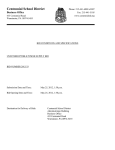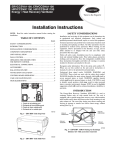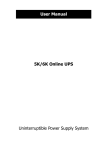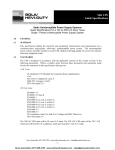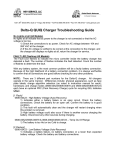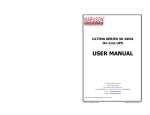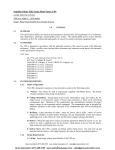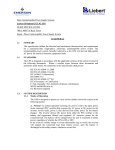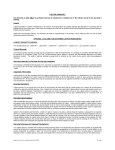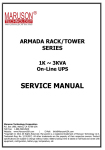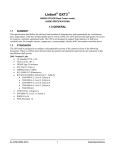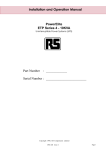Download Liebert GXT3 UPS, 500-3000VA, Guide
Transcript
Liebert® GXT3™ 500-3000VA Rack-Tower & 1000VA Mini-Tower models GUIDE SPECIFICATIONS 1.0 GENERAL 1.1 SUMMARY This specification shall define the electrical and mechanical characteristics and requirements for a continuousduty, single-phase, solid-state uninterruptible power system (UPS). The UPS shall provide high-quality AC power for sensitive electronic equipment loads. 1.2 STANDARDS The UPS shall be designed in accordance with applicable sections of the current revision of the following documents. Where a conflict arises between these documents and statements made herein, the statements in this specification shall govern. 120 and 208V Nominal Units UL Standard 1778, c-UL CSA 22.2 No. 107.1 ANSI C62.41, Category A, Level 3 IEC 61000-3-2 EN62040-2 EN61000-4-2 EN61000-4-3 EN61000-4-4 EN61000-4-5 EN61000-4-6 FCC Part 15, Class A ISTA Procedure 1A RoHS Compliant 230 Volt Nominal Units EN 62040-1:2008 CE compliance mark EN50091-1-1 EN50091-2, Class B EN50082-1 EN62040-2 EN61000-4-2 EN61000-4-3 EN61000-4-4 EN61000-4-5 EN61000-4-6 EN61000-3-2 ISTA Procedure 1A RoHS Compliant WEEE Compliant SL-23183_REV2_08-10 1 Guide Specifications Liebert GXT3 500-3000VA Rack-Tower & 1000VA Mini-Tower 1.3 SYSTEM DESCRIPTION 1.3.1 Modes of Operation The UPS shall be designed to operate as a true on-line double conversion system in the following modes: A. Normal - In normal operation incoming AC power shall be fed to the input power factor corrected (PFC) rectifier that converts the AC power to DC power for the inverter. In this mode, power shall also be derived from utility power for the battery charger. The inverter shall derive DC power from either the PFC rectifier or the battery and regenerate filtered and regulated AC sinewave power for the connected load. The battery shall be charged once the unit is connected to utility power, regardless of whether the UPS is ON or OFF. In the event of a utility outage or severe abnormality (sag or swell), the inverter shall support the connected load from battery power until the battery is discharged or the utility returns, whichever occurs first. B. Battery - Upon failure of utility / mains AC power, the critical AC load shall be supplied by the inverter, which obtains power from the battery. There shall be no interruption in power to the critical load upon failure or restoration of the utility / mains AC source. C. Recharge - Upon restoration of utility / mains AC power, after a utility / mains AC power outage, the input converter shall automatically restart and assume supplying power to the inverter and the battery charger to recharge the battery. D. Automatic Restart - Upon restoration of utility / mains AC power, after a utility / mains AC power outage and complete battery discharge, the UPS shall automatically restart and assume supplying power to the critical load and the battery charger automatically recharges the battery. This feature shall be capable of being disabled by the user. E. Bypass - The integral bypass shall perform an automatic transfer of the critical AC load from the inverter to the bypass source, in the event of an overload, PFC failure, overtemperature, DC bus overvoltage or inverter failure conditions. SL-23183_REV2_08-10 2 Guide Specifications Liebert GXT3 500-3000VA Rack-Tower & 1000VA Mini-Tower 1.3.2 Design Requirements A. Voltage: Input/output voltage specifications of the UPS shall be: Input 120V units: 208V units: 230V units: 0 - 140VAC, 50/60Hz, single-phase, 2-wire-plus-ground. 0 - 280VAC, 50/60Hz, single-phase, 2-wire-plus-ground. 0 - 280VAC, 50/60Hz, single-phase, 2-wire-plus-earth. Output 120V units: 120VAC (user configurable: 110V, 115V, 120V, 127V) ±3%, 50/60Hz, single-phase, 2-wire-plus-ground. 208V units: 208VAC (The 208V units can’t be reprogrammed for different output voltages) ±3%, 50/60Hz, single-phase, 2-wire-plus-ground. 230V units: 230VAC (user configurable: 220V, 230V, 240V) ±3%, 50/60Hz, single-phase, 2-wire-plus-earth. B. Output Load Capacity: Specified output load capacity of the UPS shall be: 500VA/450 Watts at 0.9 lagging power factor. 700VA/630 Watts at 0.9 lagging power factor. 1000VA/900 Watts at 0.9 lagging power factor. 1500VA/1350 Watts at 0.9 lagging power factor. 2000VA/1800 Watts at 0.9 lagging power factor. 3000VA/2700 Watts at 0.9 lagging power factor. C. Internal Battery: Valve-regulated, non-spillable, flame-retardant lead acid cells. D. Reserve Time: 500VA minimum: 14 minutes 700VA minimum: 9 minutes 1000VA minimum: 5 minutes 1500VA minimum: 4 minutes 2000VA minimum: 4 minutes 3000VA minimum: 4 minutes These times shall be at full load with ambient temperature of 77°F (25°C). E. Battery Recharge: The UPS shall contain a battery recharge rate designed to prolong battery life. Recharge time for UPS internal batteries shall be 3 hours to 90% capacity after a complete discharge into full load. SL-23183_REV2_08-10 3 Guide Specifications Liebert GXT3 500-3000VA Rack-Tower & 1000VA Mini-Tower 1.3.3 Performance Requirements 1.3.3.1 AC Input to UPS A. Voltage Configuration: The UPS shall operate at these values without drawing power from the batteries. 120VAC - Single phase, 2 wire plus ground nominal; variable based upon output loading: 500/700/1000/1000MT VA 120VAC Models Load Transfer Voltage Comeback Voltage 0% 70% 30% 86VAC 78VAC 60VAC 93VAC 85VAC 68VAC 1500/2000/3000VA 120VAC Models Load Transfer Voltage Comeback Voltage 90% 70% 30% 97VAC 78VAC 61VAC 104VAC 85VAC 68VAC 208VAC - Single phase, 2 wire plus ground nominal; variable based upon output loading: Load Transfer Voltage Comeback Voltage 90% 169VAC 183VAC 70% 151VAC 165VAC 30% 116VAC 130VAC 230VAC - Single phase, 2 wire plus earth nominal; variable based upon output loading: 700/1000/1500/2000VA Models Load Transfer Voltage Comeback Voltage 90% 70% 30% 169VAC 151VAC 116VAC 183VAC 165VAC 130VAC Load Transfer Voltage Comeback Voltage 90% 70% 30% 185VAC 162VAC 116VAC 199VAC 176VAC 130VAC 3000VA Model B. Frequency: UPS shall auto-sense input frequency when first powered up and shall operate within the following frequency specifications. UPS shall be capable of cold start with default frequency of 60Hz (120VAC and 208VAC units) and 50Hz (230VAC units). Once started the frequency operating window shall be 40-70Hz. Three frequency settings shall be available in the Liebert GXT3 Configuration program: Auto frequency sensing (factory default setting), 50Hz frequency conversion and 60Hz frequency conversion. C. Input Power Factor: >0.99 lagging at rated load. D. Input Current reflected distortion: 5% THD typical. SL-23183_REV2_08-10 4 Guide Specifications Liebert GXT3 500-3000VA Rack-Tower & 1000VA Mini-Tower E. Input Current Ratings UPS Model # 120VAC Units 230VAC Units 208VAC Units 500RT 700RT 1000RT 1000MT 1500RT 2000RT 3000RT120 3000RT208 4.2A 5.8A 8.3A 8.3A 12A 16A 24A N/A N/A 2.9A 3.9A N/A 5.9A 7.8A 11.7A N/A N/A N/A N/A N/A N/A N/A N/A 12.9A F. Inrush Current (initial startup, no load): The UPS shall have a maximum inrush current of 6 times the full load peak input current. G. Input Line Transient Immunity: UPS shall conform to an input line transient conforming to IEEE C62.41, Category A, Level 3 tests for 120VAC and 208VAC models. The 230VAC models shall meet EN61000-4-5. H. Surge Protection 120VAC units: MOV ratings shall be 175V, 80 Joules minimum connected L-N. 208VAC units: MOV ratings shall NOT BE LESS THAN 320V, 80 Joules minimum connected L1-L2, L1-G and L2-G. 230VAC units: MOV ratings shall NOT BE LESS THAN 320V, 80 Joules minimum connected L-N. 1.3.3.2 AC Output, UPS Inverter A. Voltage Configuration 120V units: 120VAC, 50/60Hz, single-phase, 2-wire-plus-ground, configuration program selectable (110V, 115V, 120V, 127V). 208V units: 208VAC, 50/60Hz, single-phase, 2-wire-plus-ground, configuration program selectable (The 208V unit shall not be reprogrammable for any other voltage configuration). 230V units: 230VAC, 50/60Hz, single-phase, 2-wire-plus-earth, configuration program selectable (220V, 230V, 240V). B. Voltage Regulation: +3% steady state. C. Frequency Regulation: ±5% synchronized to utility / mains. ±0.1Hz free running or on battery operation. D. Frequency Slew Rate: 1.0Hz per second maximum E. Voltage Distortion: <3% total harmonic distortion (THD) typical into a 100% linear load, <5% THD typical into a 100% non-linear load with crest factor ratio of 3:1. F. Load Power Factor Range: The rated load power factor will be 0.9 lag. G. Output Power Rating: 500VA/450 Watts, 700VA/630 Watts, 1000VA/900 Watts, 1500VA/1350 Watts, 2000VA/1800 Watts and 3000VA/2700 Watts at 0.9 lagging power factor. H. Inverter Overload Capability: 105% - 125% for 5 minutes 125% - 150% for 1 minute 150% - 200% for 2 seconds >200% for 0.25 seconds I. Voltage Transient Response: ±7% in line mode 0-100-0 % loading of the UPS ±7% in battery mode for 0-100-0% loading of the UPS rating. J. Transient Recovery Time: To nominal voltage within 90 milliseconds. K. Efficiency: ≥89% AC to AC, minimum SL-23183_REV2_08-10 5 Guide Specifications Liebert GXT3 500-3000VA Rack-Tower & 1000VA Mini-Tower 1.4 ENVIRONMENTAL CONDITIONS A. Ambient Temperature Operating: The ambient temperature range, when UPS is operational, shall be from 32°F to 77°F (0°C to 25°C). There shall not be any degradation in the performance when operating in this range. Ambient Temperature Max Output Power Factor degradation @ max load 78-86°F ±5°F (26-30°C ±3°C) 87-95°F ±5°F (31-35°C ±3°C) 96-104°F ±5°F (36-40°C ±3°C) 100%-93% 92%-86% 85%-79% Storage: 5°F to 122°F (-15°C to 40°C ) B. Relative Humidity Operating: 0 to 95% non-condensing. Storage: 0 to 95% non-condensing. C. Altitude 10,000 ft. (3,000m) max., without power derating when operated within the temperature specified in Section 1.4, Item A. Ambient temperature shall be derated 9°F (5°C) for each additional 1600 ft. (500m) above 10,000 ft. (3,000m). D. Audible Noise The audible noise of the UPS shall be: 500/700/1000VA: <43dBA max @ 1 meter front and side 1500VA: <45dBA max @ 1 meter from front and side, <46dBA max @ 1 meter from rear 2000VA - 3000VA: <48dBA max @ 1 meter from front and side, <48dBA max @ 1 meter from rear E. Electrostatic Discharge The UPS shall be able to withstand an electrostatic discharge compliant to ENC61000-4-2. 1.5 USER DOCUMENTATION The specified UPS system shall be supplied with one (1) user manual. The user manual shall include installation drawings and instructions, a functional description of the equipment with block diagrams, safety precautions, illustrations, step-by-step operating procedures and general maintenance guidelines. 1.6 WARRANTY The UPS manufacturer shall warrant the UPS against defects in materials and workmanship for two (2) years. The no-hassle replacement warranty shall include shipping to and from the customer site. Optional one (1) and three (3) year full coverage extension warranties shall be available from Emerson Network Power. 1.7 QUALITY ASSURANCE 1.7.1 Manufacturer Qualifications More than 30 years’ experience in the design, manufacture and testing of solid-state UPS systems shall be required. The manufacturer shall be certified to ISO 9001:2008. 1.7.2 Factory Testing Before shipment, the manufacturer shall fully and completely test the system to ensure compliance with the specification. These tests shall include operational discharge and recharge tests on the internal battery to ensure performance. SL-23183_REV2_08-10 6 Guide Specifications Liebert GXT3 500-3000VA Rack-Tower & 1000VA Mini-Tower 2.0 PRODUCT 2.1 FABRICATION All materials and components making up the UPS shall be new, of current manufacture and shall not have been in prior service except as required during factory testing. All relays shall be provided with dust covers. 2.1.1 Wiring Wiring practices, materials and coding shall be in accordance with the requirements the standards listed in Section 1.2 and other applicable codes and standards. All wiring shall be copper. 2.1.2 Cabinet The UPS unit shall be composed of: input PFC converter, battery charger, input filter and internal bypass circuit; and batteries consisting of the appropriate number of sealed battery cells; and shall be housed in a rack-tower NEMA type 1 enclosure and shall meet the requirements of IP20. The UPS cabinet shall be cleaned, primed and painted RAL 7021 Black. The internal battery unit shall be shipped separately and shall be installed during the UPS installation process. Dimensions and weights shall be: Model 500RT 700RT 1000RT 1000MT 1500RT 2000RT 3000RT Dimensions W x D x H, in. (mm) Weight lb. (kg) 16.9 x 19.7 x 3.4 (430 x 497 x 85) 16.9 x 19.7 x 3.4 (430 x 497 x 85) 16.9 x 19.7 x 3.4 (430 x 497 x 85) 6.9 x 15.4 x 8.9 (175 x 390 x 225) 16.9 x 19.7 x 3.4 (430 x 497 x 85) 16.9 x 19.7 x 3.4 (430 x 497 x 85) 16.9 x 23.7 x 3.4 (430 x 602 x 85) 37 (16.8) 37 (16.8) 37 (16.8) 38 (17) 51 (23.2) 52 (26) 71 (32.4) 2.1.3 Cooling The UPS shall be forced air cooled by an internally mounted, continuous fan. Fan power shall be provided from the internal DC supply. Air intake shall be through the front of the unit and exhausted out the rear of the unit. SL-23183_REV2_08-10 7 Guide Specifications Liebert GXT3 500-3000VA Rack-Tower & 1000VA Mini-Tower 2.2 COMPONENTS 2.2.1 Input Converter 2.2.1.1 General Incoming AC power shall be converted to a regulated DC output by the input converter supplying DC power to the inverter. The input converter shall provide input power factor correction (PFC) and input current distortion reduction. 2.2.1.2 AC Input Current Limit The input converter shall be provided with AC input current limiting whereby the maximum input current is limited to 125% of the full load input current rating. 2.2.1.3 Input Protection The UPS shall have built-in protection against undervoltage, overcurrent and overvoltage conditions including low-energy lightning surges, introduced on the primary AC source. The 120 and 208VAC models shall be able to sustain input surges without damage per criteria listed in ANSI C62.41, Category A, Level 3. The 230VAC UPS shall be able to sustain input surges without damage per criteria listed in EN61000-4-5. The 120V, 208V and 230V models shall have circuit breakers. 2.2.1.4 Battery Recharge The UPS shall contain a battery recharge rate designed to prolong battery life. The battery shall be constant current charged to restore capacity, then shall be constant voltage charged to maintain the battery in a fully charged state. Recharge time for the internal UPS batteries shall be five (3) hours maximum to 90% capacity (full load discharge rate). There shall be DC overvoltage protection so that if the DC voltage exceeds the pre-set limit, the UPS will shut down automatically and the critical load will be transferred to bypass. 2.2.2 Inverter 2.2.2.1 General The UPS inverter shall be a pulse-width-modulated (PWM) design capable of providing the specified AC output. The inverter shall convert DC power from the input converter output or the battery into precise sinewave AC power for supporting the critical AC load. 2.2.2.2 Overload The inverter shall be capable of supplying current and voltage for overloads exceeding 100% and up to 200% of full load current. A visual indicator and audible alarm shall indicate overload operation. For greater currents or longer time duration, the inverter shall have electronic current-limiting protection to prevent damage to components. The inverter shall be self-protecting against any magnitude of connected output overload. Inverter control logic shall sense and disconnect the inverter from the critical AC load without the requirement to clear protective devices. 2.2.2.3 Inverter DC Protection The inverter shall be protected by the following DC shutdown levels: DC Overvoltage Shutdown DC Undervoltage Shutdown (End of Discharge) DC Undervoltage Warning (Low Battery Reserve); factory default set at 2 minutes (user configurable 2 to 30 minutes). 2.2.2.4 Output Frequency The inverter shall hold the output frequency to ±0.1Hz of nominal when not synchronized to the utility/mains source. 2.2.2.5 Output Protection The UPS inverter shall employ electronic current limiting circuitry. SL-23183_REV2_08-10 8 Guide Specifications Liebert GXT3 500-3000VA Rack-Tower & 1000VA Mini-Tower 2.2.2.6 Battery Over Discharge Protection To prevent battery damage from overdischarging, the UPS control logic shall automatically raise the shutdown voltage setpoint; depending on output load at the onset of battery operation. 2.2.3 Display and Controls 2.2.3.1 General The UPS shall be provided with a microprocessor-based unit status display and controls section designed for convenient and reliable user operation. The monitoring functions such as status and alarm indicators shall be displayed on an LED display. 2.2.3.2 System Indicators UPS status shall be indicated by five symbols: fault indicator, AC input indicator, battery indicator, inverter indicator and bypass indicator. The Fault Indicator shall illuminate Red if the UPS has detected a fault; and shall be Off if there is no fault. The AC Input Indicator shall illuminate Green when the utility input power is normal; shall be Off during utility failure; and shall flash when a Line-to-Neutral reversal occurs in the AC input power supply or when there is a loss of proper grounding for the UPS. The Battery Indicator shall illuminate Amber when the battery is supplying power; and shall be Off when the battery is not supplying power. The Inverter Indicator shall illuminate Green when the inverter is supplying power; and shall be Off when the inverter is not supplying power. The Bypass Indicator shall illuminate Amber when the bypass is supplying power; shall be Off when the inverter is not supplying power; and shall flash when utility power is outside specifications. 2.2.3.3 Controls UPS startup and shutdown operations shall be accomplished by the ON and OFF push buttons on the front panel of the UPS. The ON push button shall be a means to turn the UPS on and also to manually test the battery and reset active visual and audible alarms. Pressing the OFF push button once shall allow manual transfers of the load from the inverter to bypass power. Pressing the OFF push button twice within a four-second time period when the UPS is in Bypass mode shall completely shut down the UPS and its connected load in normal and battery mode. 2.3 ON-LINE BATTERY TEST The UPS shall feature an automatic battery test with the factory default test interval set at every 2 weeks. The battery test shall ensure the capability of the battery to supply power to the inverter while loaded. If the battery fails the test, the UPS shall display a warning message to indicate the internal batteries need replaced. The battery test feature shall be user accessible by the push button on the front of the unit and with communication software. The Automatic Battery test feature shall be capable of being disabled or configured to operate every 7, 14, 21 or 28 days through the GXT3 User Configuration Program. SL-23183_REV2_08-10 9 Guide Specifications Liebert GXT3 500-3000VA Rack-Tower & 1000VA Mini-Tower 2.4 BYPASS 2.4.1 General A bypass circuit shall be provided as an integral part of the UPS. The bypass control logic shall contain an automatic transfer control circuit that senses the status of the inverter logic signals and operating and alarms conditions. This control circuit shall provide a transfer of the load to the bypass source if available and if the inverter is capable of powering the load (i.e., if there is an overload condition, if the unit is in Manual Bypass Mode or if the voltage or frequency is out of tolerance). 2.4.2 Automatic Transfers The transfer control logic shall activate the bypass automatically, transferring the critical AC load to the bypass source, after the transfer logic senses one of the following conditions: UPS overload UPS overtemperature PFC failure Inverter failure DC bus overvoltage Once the overload condition is reduced, the load shall be automatically transferred back to inverter power. 2.5 INTERNAL BATTERY Valve-regulated, non-spillable, flame-retardant lead acid cells shall be used as a stored-energy source for the specified UPS system. The battery shall be housed internal to the UPS cabinet and sized to support the inverter at rated load and power factor, with ambient temperature of 25°C (77°F) for a minimum of 7 minutes reserve time. The expected life of the battery shall be 3-5 years or a minimum 250 complete discharge cycles. The UPS units have the capability to allow the operator to replace the internal battery. 2.6 OUTPUT DISTRIBUTION Output distribution shall be integral to the UPS and located on the rear of the unit. Model 120VAC Units 230VAC Units 208VAC Units 500RT 700RT 1000RT 1000MT 1500RT 2000RT (6) NEMA 5-15R (6) NEMA 5-15R (6) NEMA 5-15R (6) NEMA 5-15R (6) NEMA 5-15R (6) 5-20R (T-Slot) (6) 5-20R (T-Slot) (1) NEMA L5-30R N/A (6) EN60320/C13 (6) EN60320/C13 N/A (6) EN60320/C13 (6) EN60320/03 (6) EN60320/03 (1) EN60320/09 N/A N/A N/A N/A N/A N/A N/A N/A 3000RT120 3000RT208 SL-23183_REV2_08-10 10 N/A (2) NEMA L6-15R (1) NEMA L6-20 Guide Specifications Liebert GXT3 500-3000VA Rack-Tower & 1000VA Mini-Tower 2.7 COMMUNICATION OPTIONS 2.7.1.1 Liebert IntelliSlot® Communications The UPS shall include one Liebert IntelliSlot communication port to allow the operator to field-install an optional Liebert IntelliSlot communication card. A Liebert IntelliSlot card may be installed during any state of UPS operation (On, Standby or Off states). Available Liebert IntelliSlot options are described below. Liebert IntelliSlot Web Card (IS-WEBCARD) The optional Liebert IntelliSlot Web Card shall deliver SNMP and Web management to the UPS when connected to any 10 or 100 Mbit Ethernet network. The card shall support 10 and 100 Mbit Ethernet and shall provide for in-the-field upgrade of SNMP firmware. The kit shall include the Liebert IntelliSlot card, MIB, configuration cable and user manual. Liebert IntelliSlot Relay Interface Card (RELAYCARD-INT) The optional Liebert IntelliSlot Relay Interface Card shall provide contact closure for remote monitoring of alarm conditions in the UPS, delivering signals for On Battery, On Bypass, Low Battery, Summary Alarm, UPS Fault and On UPS. The contacts shall be rated for 24VAC or 24VDC at 1A. Connections shall be to a DB25F connector with cable provided by the end user. 2.7.1.2 Any-Mode Shutdown The purpose of Any-Mode Shutdown shall be to shut down the UPS output by turning Off the rectifier, inverter and bypass so that there is no power to the loads. Any-Mode Shutdown can be operated locally and remotely, as described as follows: Local Any-Mode Shutdown can be performed by shorting Pin 1 and Pin 2 Remote Any-Mode Shutdown can be performed by a switch connected to Pin 1 and Pin 2 and mounted at a remote location. Remote Power Off shall be performed either by NO or NC contact of Any-Mode Shutdown, depending on the settings in the configuration program. A current-limited source (+12VDC, 50mA) shall be available from the UPS. The connection to the UPS for remote connection shall be via terminal block connector. Any-Mode Shutdown wiring shall conform to all national, regional and local wiring regulations. 2.7.1.3 Battery Mode Shutdown Battery Mode Shutdown shall permit shutting down the UPS by turning Off the rectifier, inverter and bypass so that there is no power to the load when the UPS is On Battery. Battery Mode Shutdown can be performed locally or remotely: Local Any-Mode Shutdown can be performed by shorting Pin 3 and Pin 4. Remote Any-Mode Shutdown can be achieved by a switch connected to Pin 3 and Pin 4 and mounted at a remote location. On Battery On Battery signal shall be a Normally Open (NO) dry contact. When the UPS is supplying output power from the battery this dry contact shall be closed. Low Battery Low Battery signal shall be a Normally Open (NO) dry contact. When the UPS is supplying output power from the battery and has reached the Low Battery Warning time selected in the configuration program, this dry contact shall be closed. The rated values for the dry contacts shall be: Rated Voltage: 5V Working Voltage Range: 4.5-10V Rated Current: 30mA SL-23183_REV2_08-10 11 Guide Specifications Liebert GXT3 500-3000VA Rack-Tower & 1000VA Mini-Tower 2.8 LIEBERT GXT3 CONFIGURATION PROGRAM An included Microsoft® Windows®-based (Windows 95 or later) Configuration Program and cable shall allow configuration of UPS features and operating parameters to meet specific application requirements, if required. Options that are configurable via this program shall include: Select one of five input/output voltages to match voltages found around the world. Enable / Disable Auto-Restart. Disable the Line-Neutral-Reversal/Missing-Ground receptacle wiring alarm. Select frequency converter operation with a fixed output frequency of 50 or 60Hz. Set the Low Battery Warning alarm time from 2 to 30 minutes. Disable the Auto-Battery test. Set the Auto-Battery test to 7, 14, 21 or 28 days. Select the number of external battery cabinets connected to the UPS to adjust the remaining run-time calculations reported by the UPS Liebert software products. SL-23183_REV2_08-10 12 Guide Specifications












